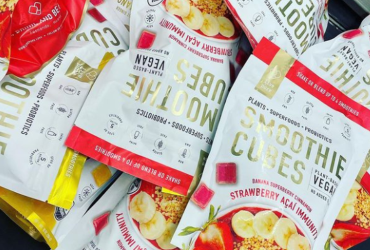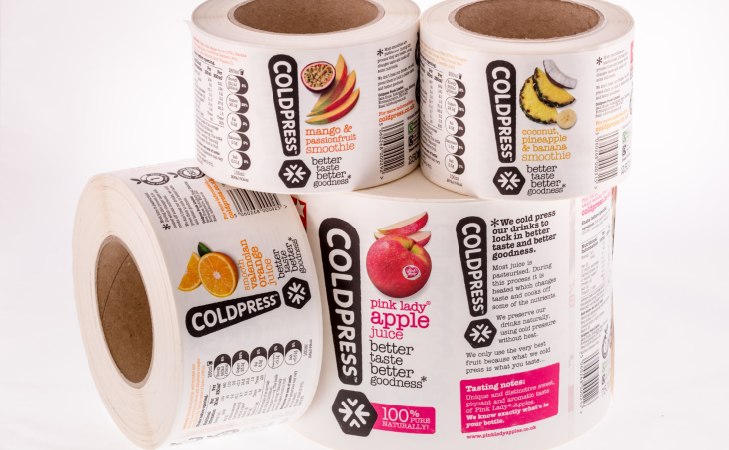Keeping products fresh and secure is vital, however just as important is the preservation of its packaging and labels, particularly for packaging in fresh and frozen environments. Taylor Sinclair reports
Cold and sub-zero temperatures offer a variety of challenges for packaging manufactures, resulting in a change in pre-press operations, material used and flexibility of packaging to adapt the substrate being used, so that its characteristics make it suitable to print on. This is acted upon to ensure digitally printed products’ print quality is maintained at a high-quality following storage for days, weeks, months and even years in frozen/cold environments.
Considerations must be taken into account for the whole process of printing on products set to be stored in a freezer. Aleksi Pekkanen, senior researcher, technology at UPM underlines the ink, coating and lamination as areas which require thought before production. He expounds, ‘Use inks specifically formulated for cold temperatures. These inks should have properties such as low viscosity to prevent clogging at lower temperatures, fast drying to avoid smudging, and good adhesion to various substrate.
‘Apply coatings or laminates to protect the printed surface from moisture, condensation and other environmental factors commonly encountered in cold storage. These coatings can enhance durability and prevent ink smudging or fading.’ Sharon Beeman, VP of Global sales at S-OneLP further expands upon Mr Pekkanen’s view of coatings, stating, ‘Lamination is preferred with frozen food applications; it provides another layer of protection for the ink on top of the packaging. If you use an E-beam (electron beam) coating it secures everything together; the primer, the substrate, the ink and the over-print varnish coating, creating a very strong seal in the ink.’ Both points evaluate the importance of protecting the ink, preventing damage from the conditions it’s stored in.
Keeping it flexible
One company, ePac Flexibles, a global technology-driven custom flexible packaging company, focuses on the flexibility of it’s packaging to make it suitable for all storage environments. Maria Lyri, ePac Flexible Packaging’s marketing manager enforces the importance of flexible packaging commenting, ‘Consumer feedback suggests that flexible packaging is much more valuable and more effect in comparison to rigid packaging,’ describing flexible packaging as ‘ideal for the freezer as there is less space.’ This is a view agreed with by Ms Beeman, who through the disagreement of rigid packaging, opines that flexible packaging is more suitable for freezer applications; ‘Something that has large sharp edges means we have to adapt the packaging to prevent punctures, so a switch to a puncture resistant packaging is necessary.’ An opinion expanded upon by Christine Barrington, technical sales, Taylor Prime Labels and Packaging who adds, ‘Sometimes you’ll see nylon incorporated into frozen structures for puncture resistance.’
As commented prior, flexible packaging is connoted as a viable and ideal option for frozen environments. The main benefit of packaging for sub-zero environments is explained by Ms Beeman who states, ‘Because it is frozen food, you don’t need a high barrier packaging for the product, as the freezer is the barrier.’ Explained further by Ms Lyri, who implies, ‘Prints are the same in frozen and room temperature conditions,’ highlighting the barrier of packaging as the main contrast for room-temperature and frozen storage. She further elucidates, agreeing with Ms Beeman, that low barrier packaging is appropriate for this application as the frozen environment acts as protection for the product inside the packaging.
‘The only thing that varies is the material used. So, the structure of packaging differs, for example, when freezing something you don’t need a high barrier protection because your goods are frozen, so less barrier is required. Whereas, in room temperature conditions you would need a higher barrier to protect the food inside the packaging,’ she says. Once again further expanded upon by Ms Barrington commenting, ‘In general for frozen foods you don’t need oxygen or moisture barrier because the freezer itself provides that, so PET/LLDPE structures are very common in frozen applications,’ suggesting the lack of need for high barrier packaging.

Flexible packaging is beneficial to consumers, described as ‘ideal for the freezer as there is less space’
Flexible packaging subsequently benefits this sector, providing more options for brands, adhering to consumer needs and wants. Ms Lyri adds to this opinion telling Digital Labels & Packaging: ‘We are much more flexible when it comes to frozen food packaging because of the fact we don’t need such a high barrier material, meaning more options become available to our customers.’
Digital prints place in the freezer
Digital printing has many benefits; eradicating packaging obsolescence, customisation and quick turnaround times. Ms Lyri explains how the method of digital printing is the main facilitator in reducing costs for brands investing in flexible packaging. She says, ‘Digital printing means there is lower costs in producing smaller quantities, for seasonal products, special editions; this can be done at lower costs due to digital printing. We can provide high levels of customisation, allowing brands to create unique designs, tailoring them to specific applications and audiences.’ ProAmpac’s product development director Lynsey Maddison added, ‘This flexibility [of digital printing] not only enhances shelf presence but also minimises inventory costs and waste, aligning perfectly with the fast-paced nature of the fresh and frozen food market.’
As explained by Ms Maddison, eradicating packaging obsolescence is a benefit to the frozen packaging market, made possible by digitally printing. Mr Pekkanen adds, ‘Digital printing enables on-demand printing, allowing manufacturers to print only the quantity needed at any given time. This helps minimise inventory costs and waste, especially for products with short shelf lives or seasonal variations in demand.’ Dr Adrian Steele, managing director of Mercian Labels, further consolidates the benefit of digital printing’s ability to eradicate waste. He explains, ‘There is a high degree of complexity that is completely embedded in the food packaging market, where brands want to change their packaging quite frequently, to present in different ways. Digital print offers a superb solution for that. You can change your mind so quickly without fear of stock obsolescence.’
Despite the highlighted benefits, is the process much different to printing on packaging for ambient product? Mr Steele comments, ‘We treat frozen packaging the exact same as ambient packaging,’ similarly agreed with by Ms Lyri, stating, ‘We are not supplying anything different in terms of how we print.’
As connoted by both Mr Steele and Ms Lyri, the process of digital printing isn’t amended, instead what differs from ambient packaging is the substrate used and its properties, the lamination and coatings applied to protect the ink from the factors encountered in the freezer – the main one being the cold!
This feature article was first published in the May/June issue of Digital Labels & Packaging, which you can read online here; register here to receive future issues of the magazine






